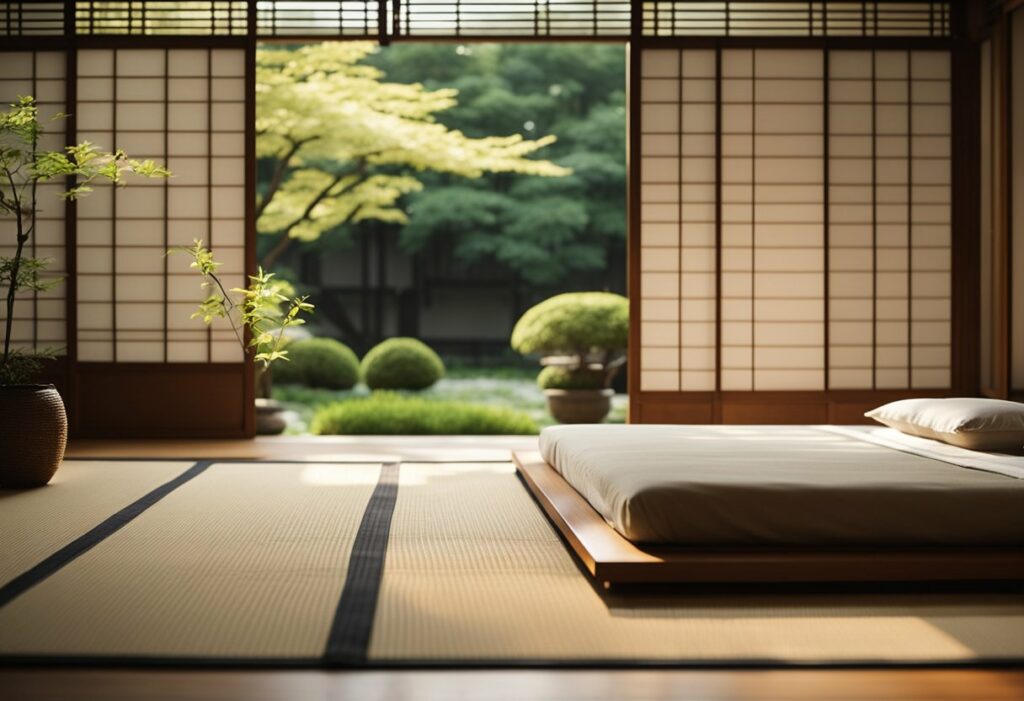Japanese Interior Design Bedroom: Creating a Tranquil and Minimalist Space
If you’re looking to create a peaceful and serene bedroom, Japanese interior design may be just what you need. With its focus on minimalism, simplicity, and natural elements, Japanese-style bedrooms can help you achieve a sense of calm and relaxation that’s perfect for getting a good night’s sleep.
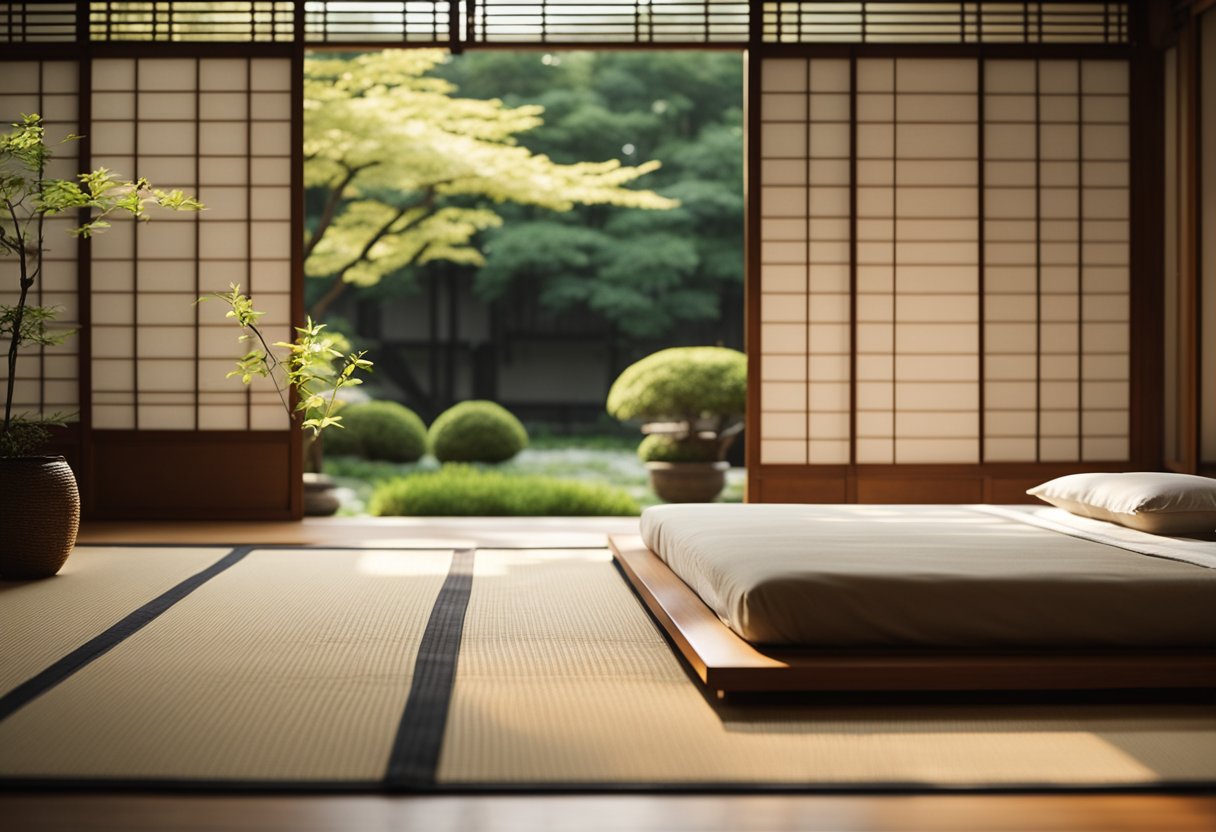
When designing your Japanese-style bedroom, it’s important to keep in mind the principles of Zen philosophy. This includes using natural materials like wood and stone, keeping clutter to a minimum, and creating a sense of balance and harmony in the space. You may also want to incorporate traditional Japanese elements like tatami mats, shoji screens, and sliding doors to create a space that truly reflects Japanese culture.
Overall, Japanese interior design is a great way to create a bedroom that’s both beautiful and functional. By incorporating natural elements, minimalism, and a sense of balance and harmony, you can create a space that’s perfect for relaxation and rest. So why not give it a try and see how it can transform your bedroom?
Key Takeaways
- Japanese interior design focuses on minimalism, simplicity, and natural elements to create a peaceful and serene bedroom.
- When designing your Japanese-style bedroom, keep in mind the principles of Zen philosophy and incorporate traditional Japanese elements to reflect the culture.
- By incorporating natural elements, minimalism, and a sense of balance and harmony, you can create a beautiful and functional space that’s perfect for relaxation and rest.
Designing Your Japanese-Style Bedroom
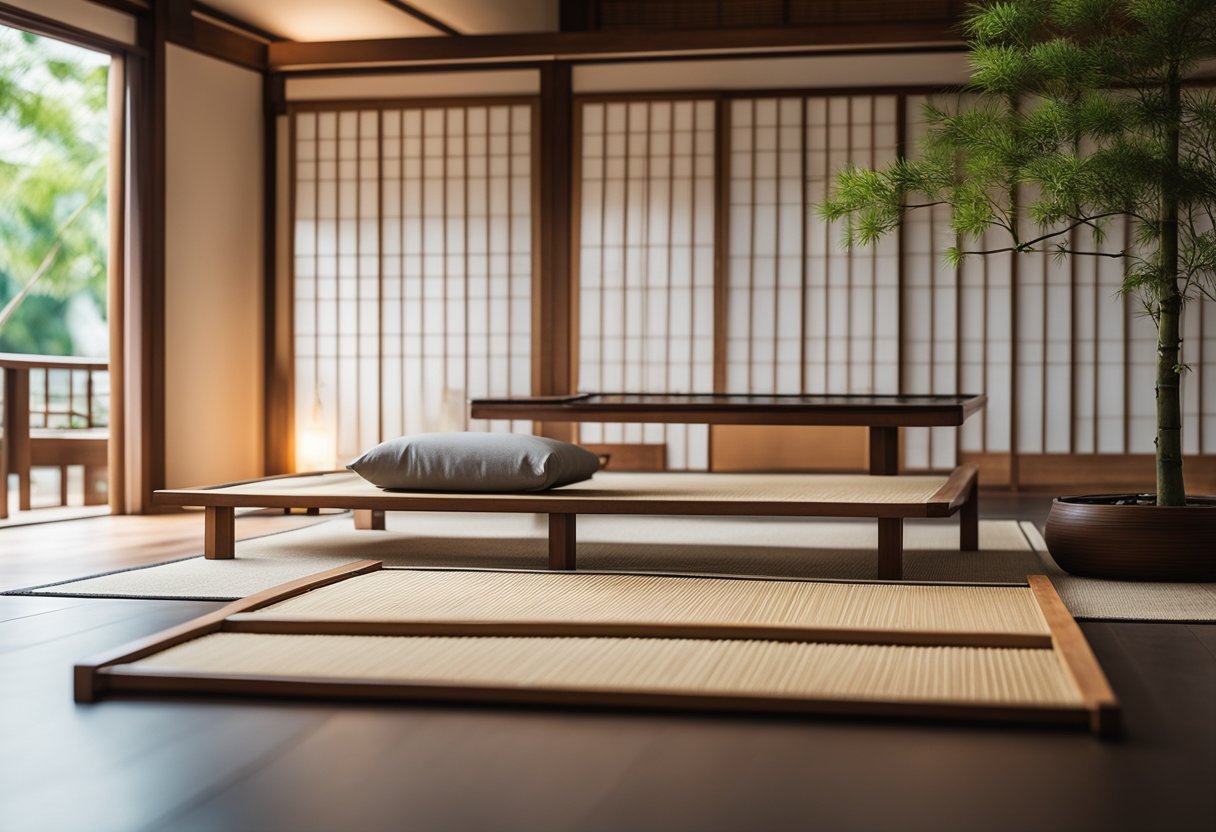
Creating a Japanese-style bedroom is all about simplicity, natural elements, and creating a space that promotes relaxation and serenity. Here are some key factors to consider when designing your Japanese-inspired bedroom.
Understanding the Concept of ‘Ma’ and Simplicity
One of the fundamental principles of Japanese interior design is the concept of ‘ma’, which refers to the space between objects. This concept highlights the importance of simplicity and minimalism in creating a serene and uncluttered space. To achieve this, you can opt for low furniture, decluttering your space, and choosing functional pieces that serve multiple purposes.
Choosing the Right Furniture and Decorations
When selecting furniture and decorations for your Japanese-style bedroom, consider pieces made from natural materials such as wood and fabrics like cotton and linen. A low platform bed or a futon mattress can add a touch of authenticity, while a shoji screen or sliding doors can create a sense of privacy and separation.
Incorporating Traditional and Modern Elements
While traditional Japanese furniture and decorations can create an authentic look, incorporating modern elements can add a touch of contemporary style. You can achieve this by adding industrial-style lighting or a modern coffee table to your space.
Lighting and Spatial Harmony
Lighting is a crucial element in creating a Japanese-style bedroom. Natural light is ideal, but if this is not possible, you can use Japanese lanterns or paper lanterns to create a soft and warm ambiance. Additionally, spatial harmony can be achieved by creating a balance between light and shadow, or by using a combination of natural and artificial lighting.
Textures and Materials
Incorporating natural materials such as wood, stone, and natural fabrics can add a touch of authenticity to your Japanese-style bedroom. Textiles such as tatami mats and floor cushions can also add texture and warmth to your space.
Colour Schemes and Visual Balance
A Japanese-style bedroom is typically characterized by a neutral colour palette, with white, beige, and light grey being popular choices. You can add visual interest by incorporating dark wood or using prints inspired by Japanese koi or other natural elements.
Accessorising with Cultural Significance
Adding decorative items such as pillows or a mural with cultural significance can add a touch of authenticity to your Japanese-style bedroom. You can also incorporate elements such as a kimono or other traditional Japanese clothing as a decorative piece.
Innovative Storage Solutions
In a Japanese-style bedroom, storage solutions should be functional and unobtrusive. You can achieve this by incorporating low furniture with built-in storage or using decorative baskets and boxes to keep your space clutter-free.
Creating a Meditative and Restful Environment
A Japanese-style bedroom is all about promoting relaxation and serenity. You can achieve this by incorporating elements such as a low bed, a futon mattress, or a meditation corner with a floor cushion.
Embracing Wabi-Sabi and Imperfection
Wabi-sabi is a Japanese aesthetic that embraces imperfection and the natural world. You can incorporate this concept into your Japanese-style bedroom by using imperfect or weathered furniture, or by adding indoor plants to bring a touch of the natural world indoors.
Adapting to Small Bedroom Spaces
In a small bedroom space, minimalist design is crucial. To create a Japanese-style bedroom in a small space, opt for a low bed, declutter your space, and use functional pieces that serve multiple purposes.
Bedding and Sleep Comfort
In a Japanese-style bedroom, bedding should be comfortable and functional. You can achieve this by using a futon mattress or incorporating tatami mats into your space.
Flooring Options for Authenticity
To create an authentic Japanese-style bedroom, consider using tatami mats or other natural flooring options such as wood or stone.
Window Treatments and Privacy
Privacy is an important element in a Japanese-style bedroom. You can achieve this by using screen doors or shoji screens, or by incorporating window treatments that provide privacy while still allowing natural light to enter your space.
Incorporating Nature Indoors
Incorporating elements of the natural world into your Japanese-style bedroom can promote relaxation and serenity. You can achieve this by adding indoor plants or using natural materials such as wood or stone.
Combining Japanese and Western Influences
Combining Japanese and Western influences can create a unique and contemporary look. You can achieve this by incorporating modern lighting or furniture into your Japanese-style bedroom.
Maintaining a Clean and Uncluttered Space
In a Japanese-style bedroom, cleanliness and minimalism are key. You can achieve this by decluttering your space regularly and incorporating innovative storage solutions.
Exploring Contemporary Trends in Japanese Bedroom Design
Contemporary trends in Japanese bedroom design include incorporating elements such as industrial-style lighting or modern furniture into your space. You can also experiment with different colour schemes or textures to create a unique and contemporary look.
Cultural Reflection and Personal Expression
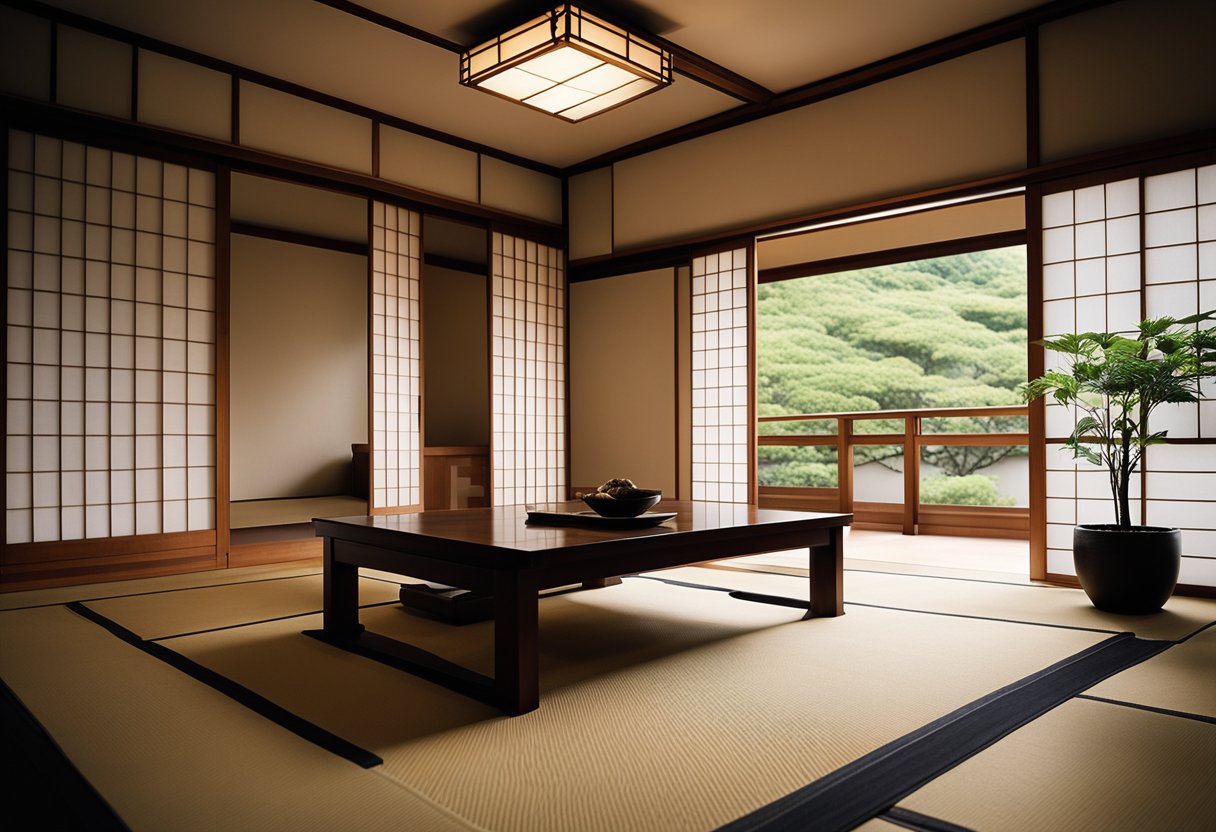
Japanese interior design is much more than just a style; it is a reflection of Japanese culture, philosophy, and aesthetics. By embracing these principles, you can create a bedroom that is not only beautiful but also deeply personal.
Understanding Japanese Aesthetics and Philosophy
Japanese aesthetics are rooted in the principles of simplicity, minimalism, and the beauty of imperfection. Wabi-sabi is an essential concept that celebrates the beauty of the imperfect and the transient. It is the art of finding beauty in imperfection and profundity in nature. By embracing wabi-sabi, you can create a bedroom that is both calming and inspiring.
Expressing Individuality within the Design
Japanese interior design is not about conforming to a particular style or trend. Instead, it is about expressing your individuality and creating a space that reflects your personality and tastes. You can do this by incorporating unique and handmade items into your bedroom design.
Integrating Art and Sculpture
Art and sculpture are an integral part of Japanese interior design. You can use traditional Japanese art, such as calligraphy, paintings, and prints, to create a serene and tranquil atmosphere in your room. Japanese art is known for its simplicity, elegance, and minimalism.
Influences of Japanese Architecture on Interior Design
Japanese architecture has a significant influence on interior design. The use of natural materials, such as wood and stone, is common in Japanese architecture and can be incorporated into your bedroom design. You can also use sliding doors and screens to create a sense of openness and flow in your space.
The Role of Textiles and Fabrics
Textiles and fabrics play a crucial role in Japanese interior design. Natural fabrics, such as cotton and linen, are preferred over synthetic materials. You can use traditional Japanese textiles, such as kimono fabric, to create a unique and personalised look.
Incorporating Symbolism and Meaning
Japanese culture is rich in symbolism and meaning, and you can incorporate these elements into your bedroom design. For example, the Japanese koi symbolises strength and perseverance, while the cherry blossom represents beauty and the transience of life.
Personalising with Handmade and Unique Items
One of the best ways to personalise your bedroom design is to incorporate handmade and unique items. You can use ceramics, pottery, and other decorative items to add character and personality to your space.
Reflection of the Natural World in Design
Japanese interior design is deeply influenced by the natural world. You can incorporate natural elements, such as plants and stones, into your bedroom design to create a sense of harmony and balance.
Embracing Seasonal Changes in Decor
Seasonal changes are an essential part of Japanese culture, and you can reflect this in your bedroom design. You can change your decorations and accessories to reflect the changing seasons, creating a sense of ambiance and connection to nature.
Incorporating these elements into your bedroom design can create a space that is not only beautiful but also deeply personal and reflective of Japanese culture and philosophy.
Frequently Asked Questions
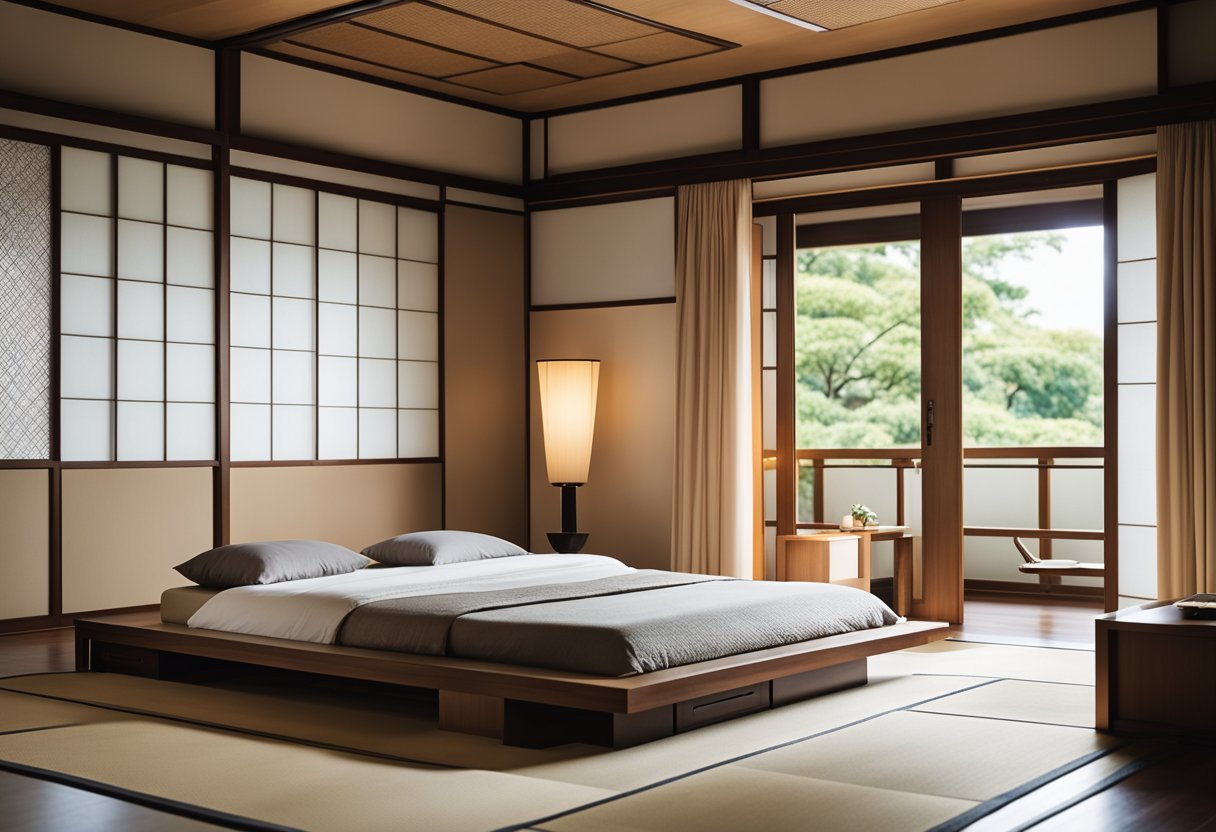
How can one maximise space in a compact Japanese-inspired bedroom?
If you have a small bedroom, you can still create a Japanese-inspired design that maximizes space. One way to achieve this is by using minimalistic furniture that serves multiple purposes. For example, you can use a low platform bed with built-in storage drawers or a wardrobe that doubles as a room divider. Another trick is to use sliding doors, which take up less space than traditional doors.
What essential elements define a Japanese-themed bedroom interior?
A Japanese-themed bedroom interior typically features a low platform bed, tatami flooring, shoji screens for windows, and minimalistic furniture. The colour palette is usually muted and calm, with shades of beige, white, and grey dominating the space. Natural materials such as wood, bamboo, and paper are also commonly used.
Which colour palettes are typically used to create a tranquil Japanese bedroom atmosphere?
To create a tranquil Japanese bedroom atmosphere, you should use a colour palette that is muted and calm. Shades of beige, white, and grey are the most common, but you can also use soft greens, blues, and browns. Avoid bright or bold colours that can be too stimulating and disrupt the peaceful atmosphere.
What modern twists can be added to traditional Japanese bedroom designs?
To add a modern twist to a traditional Japanese bedroom design, you can incorporate elements of Japandi style, which combines Japanese and Scandinavian design. You can also add a pop of colour with accessories such as cushions or a rug, or use contemporary lighting fixtures.
How can IKEA products be utilised to achieve a Japanese style bedroom aesthetic?
IKEA products can be utilised to achieve a Japanese style bedroom aesthetic by choosing minimalistic and functional pieces that fit the design principles. For example, you can use a low platform bed like the MALM series, or a wardrobe with sliding doors like the PAX series. You can also use paper lanterns or bamboo blinds for window treatments.
What are some budget-friendly tips for adding Japanese decor touches to a bedroom?
If you’re on a budget, you can still add Japanese decor touches to your bedroom. One way to do this is by using DIY projects such as creating a shoji screen room divider using PVC pipes and paper. You can also use natural materials such as bamboo or rattan for accessories like baskets or plant holders. Another tip is to use washi tape to create a minimalist geometric design on your walls or furniture.

